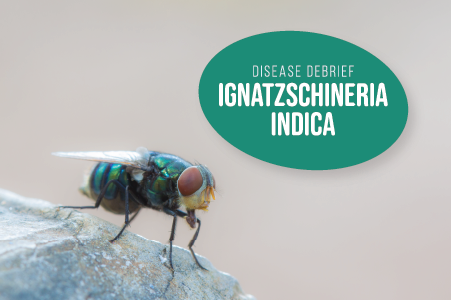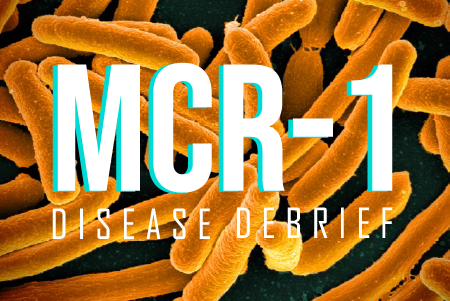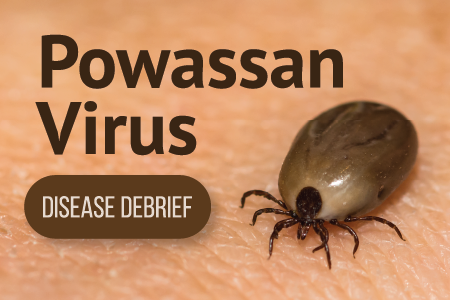Purpose
NCCID Disease Debriefs are designed to offer timely and up-to-date knowledge on emerging and re-emerging infectious diseases for Canadian public health audiences. Disease Debriefs connect readers to clinical and public health guidance, evidence, and other sources of information.
Disease Debriefs are typically organized to answer four main public health-related questions: What are important characteristics of the disease? What is happening with current outbreaks of the disease? What is the current risk for Canadians? What measures should be taken for a suspected disease case or contact?
Our aim is to provide public health personnel with crucial information in a concise format to aid in prompt identification, treatment and management.
Methods
NCCID Disease Debriefs are not comprehensive or systematic reviews of peer-reviewed literature, but instead provide a concise reference with links to more detailed information. NCCID ensures that all information and content is accurate and from reputable sources. Information is gathered from the Public Health Agency of Canada (PHAC), the USA Centers for Disease Control and Prevention (CDC), and the World Health Organization (WHO). In addition, information from provincial public health offices and laboratories is provided, particularly case numbers during an outbreak. Links to media reports and informational videos may be included to describe new outbreaks. In instances when only limited information is available from these sources, peer-reviewed literature, reference manuals and books, and other websites may be used.
Occasionally, web-based information is noted as archived, however NCCID has verified the credibility of the archived content and has included a note to alert readers.
NCCID acknowledges that information provided by different organizations and websites may sometimes be contradictory. Readers are encouraged to follow the links and find relevant provincial or territorial guidance as well.

Coronavirus disease (COVID-19)
There is a range of COVID-19 disease severity, ranging from asymptomatic or mild, to moderate, severe and critical disease.
The most commonly observed symptoms of COVID-19 infection are fever, flu, fatigue, new or worsening
cough, loss of appetite, loss of smell and/or taste, muscle and body ache, and headache.
Anaplasmosis
The number of Anaplasmosis infections reported around the world have been steadily increasing since the first reported case of in 1990. Ticks carrying Anaplasma phagocytophilum have been identified in North America, Europe, and Asia, with the highest incidence in North America.
Bartonella
Bartonellosis is a group of infectious diseases caused by bacteria within the Bartonella genus. The bacteria are fastidious, aerobic, gram-negative cocci/small rods, and are hemotropic. The bacteria invade erythrocytes and the lining of blood vessels where they then proliferate.
Blastomycosis
Blastomycosis is a pulmonary, cutaneous or disseminated infection caused by the fungus Blastomyces dermatitidis (B. dermatitidis). This fungus exists in mold form in the environment; it produces microscopic fungal spores, particularly in moist soil and in decomposing matter such as wood and leaves.
Brucellosis
Brucellosis occurs commonly in areas without effective public health and domestic animal health programs. The biggest risk comes from consuming unpasteurized milk and milk products, which tends to be more common outside of the U.S.A but is also becoming more common all over North America as well.
Candida auris
Candida auris infection is difficult to diagnose, and missed diagnosis may lead to spread. It is difficult to treat, and its multidrug resistance also leads to concern of further transmission. There is a high propensity for outbreaks. All of these factors make C. auris a public health concern.
Chikungunya
Chikungunya virus (CHIKV) is an arbovirus that causes Chikungunya fever. The virus was first detected in Tanzania in 1952. Since then, it has spread to over 110 countries: outbreaks have occurred in Africa, the Americas, Asia, Europe, and islands in the Indian and Pacific Oceans. The expansion of the range of Aedes aegypti and Aedes albopictus mosquitoes because of climate change may further the spread of infection.
Congenital Syphilis
Congenital syphilis is a sexually transmitted bacterial disease passed from mother to child during pregnancy or birth. When left untreated, syphilis in pregnant women can cause serious health consequences including miscarriage, stillbirth, neonatal death, or birth defects. Congenital syphilis is re-emerging and has risen significantly in recent years. In 2019, for example, there were 53 cases of congenital syphilis, the highest number of cases ever reported in Canada. Case counts have risen significantly since 2019 in the provinces, although numbers for the country as a whole are not yet available.
Coronavirus disease (COVID-19)
The Coronavirus disease (COVID-19) is caused by SARS-COV-2 coronavirus, a virus strain never previously identified in humans. The genetic sequence indicates that it is a betacoronavirus, closely linked to the SARS virus. The government of Canada has issued COVID-19 pandemic guidance for the health sector for federal, provincial and territorial health authorities.
Dengue
Dengue is a viral infection caused by the bite of infected Aedes mosquitoes.
In Canada, approximately 200-300 cases of dengue are imported each year. All cases have been among travellers returning from countries where dengue is present.
Ebola
Canada has protocols and resources to detect, investigate, and manage Ebola cases if it were ever to appear in the country. As of July 22, 2019 Ebola virus disease in DRC is at level 2 risk due to an outbreak that is only in limited geographic areas
EV-D68
Because there appear to have been relatively few observations and analyses of cases and outbreaks specifically associated with EV-D68, much of the information in this Disease Debrief is based on incomplete information from current and previous reports of outbreaks or has been extrapolated from what has been known about similar viruses. Questions, comments or suggestions would be most appreciated.
Francisella tularensis (Tularemia Disease)
Tularemia is a bacterial disease that can infect animals and people. In North America, this disease is found in wild animals which include rodents, rabbits, muskrats and beavers. Humans can become infected by tick and deer fly bites, through skin contact with infected animals, drinking contaminated water, and inhaling contaminated aerosols or agricultural and landscaping dust.
Group A Streptococcus
Group A streptococcus (GAS) is responsible for a range of diseases in humans. These diseases include strep throat (acute pharyngitis) and skin and soft tissue infections such impetigo and cellulitis. These can also include rare cases of invasive (serious) illnesses such as necrotizing fasciitis (flesh eating disease) and toxic shock syndrome (TSS).
H5N1 Highly Pathogenic Avian Influenza A Virus (Bird Flu)
H5N1 AI is a highly pathogenic avian influenza virus that is easily transmitted between birds and is a zoonotic disease (a disease that transmits from animals to people), but it is not well adapted to mammals. There have been reports of possible limited human-to-human transmission, but there has been no evidence of ongoing transmission between people.
Hand, Foot, and Mouth Disease (HFMD)
Hand, Foot, and Mouth Disease (HFMD) is a highly contagious disease caused by a virus belonging to Enteroviruses. Symptoms usually include fever, mouth sores, and a skin rash commonly found on the hands and feet.
Hantavirus
Are you looking for the PHAC guidance document for practitioners? This debrief will focus on HPS/HCPS as this is most…
Helicobacter pylori
Treatment for H. pylori infection involves taking a combination of antibiotics and a proton pump inhibitor (PPI) to reduce the amount of acid in the stomach (acid suppression). Most people do not need to be tested for H. pylori if they do not show signs of infection.
Ignatzschineria indica
Ignatzschineria indica (I. indica) infection is caused by myiasis, the infection of human tissue by fly larvae. It is transmitted by the larvae (maggots) of flesh flies (Sarcophaginae) and blow flies (Calliphoridae).
Legionella
Legionellosis is caused by Legionella species, small, gram-negative, aerobic bacilli that are found in natural and man-made environments such as cooling towers, potable water systems, lakes, rivers, and streams. Legionella spp. can also be found in soil.
Legionellosis can manifest as 2 distinct syndromes: Legionnaires’ disease (a form of atypical bacterial pneumonia) and Pontiac fever.
Leprosy
Leprosy, also known as Hansen’s disease, is caused by the bacterium Mycobacterium leprae. This chronic infection primarily targets the skin, peripheral nerves, mucosa of the upper respiratory tract, and ocular tissues, leading to disfiguring sores and nerve damage.
Listeriosis
Listeriosis is a serious infection caused by Listeria monocytogenes, a bacterium commonly found in the environment. The bacterium can contaminate various foods and water sources:although cases are relatively rare, outbreaks can be of serious public health concern Rates range from 0.1 to 10 cases per million people annually, depending on the countries and regions of the world.
Lyme Disease
Lyme disease is a bacterial infection caused by Borrelia burgdorferi. It spread through the bite of infected ticks. Ticks attach to any part of the human body but are often found in hard-to-see areas. In most cases, the tick must be attached for at least 24 hours before Lyme disease can be transmitted.
Malaria
Malaria is a parasitic infection spread to humans by female Anopheles mosquitoes. The single-celled parasites are in the genus Plasmodium. Typically, four kinds of malarial parasites infect humans, Plasmodium falciparum, P. vivax, P. ovale, and P. malariae. P. Knowlesi, a type of malaria that naturally infects macaques in Southeast Asia, may also infect humans, causing malaria that is transmitted from animal to human.
Marburg virus disease
Marburg virus is the causative agent of Marburg virus disease (MVD) formerly known as Marburg haemorrhagic fever. MVD is a zoonotic infection, transmitted from animals to humans. It is a highly virulent disease that causes hemorrhagic fever with an 88% fatality rate. The virus can spread by human-to-human contact with blood, body fluids and by contact with infected body fluid objects.
Measles
Measles is a single stranded, enveloped RNA virus. The virus can cause a measles infection which starts in the respiratory epithelium of the nasopharynx. Measles is highly contagious. Complications from measles commonly include ear infections and diarrhea.
MERS-CoV
Middle East respiratory syndrome (MERS) is a viral respiratory caused by the Middle East respiratory syndrome coronavirus (MERS-CoV). It is a zoonotic virus that is transmitted from infected dromedary camels to humans.
Mobilized Colistin Resistance (MCR-1)
MCR-1 is an acronym for Mobilized Colistin Resistance. It protects bacteria from a polypeptide antimicrobial called colistin (polymyxin E). The gene responsible has been found in bacteria from food animals, raw meat and human samples.
mpox
Mpox virus (formerly Monkeypox) is a zoonotic, double-stranded DNA virus, which also includes the variola virus (smallpox), cowpox virus, and vaccinia virus.
Recent research has reclassified the mpox virus into two distinct clades, now officially referred to as Clade I (formerly the Central African or Congo Basin clade) and Clade II (formerly the West African clade).
Multidrug Resistant Tuberculosis
Multidrug resistant TB (MDR TB) is a disease caused by any strain of Mycobacterium tuberculosis which is not effectively killed by both isoniazid and rifampin, two of the first-line, safest and most effective anti-TB medications.
Mumps
Mumps infection is caused by the mumps virus, an enveloped, negative-sense, single stranded RNA virus which belongs to the Rubulavirus genus in the Paramyxoviridae family.
Mycoplasma genitalium
Mycoplasma genitalium (M. genitalium, or Mgen) is a small facultative anaerobic bacterium and a risk group 2 pathogen. M. genitalium is sexually transmitted through direct mucosal contact. Infections can be asymptomatic or symptomatic, and evidence has suggested persistent infections do occur.
Naegleria Fowleri
Naegleria fowleri is a type of single-celled organism called a free-living amoeba. It lives in soil and warm freshwater and is distributed worldwide. Naegleria fowleri is generally harmless to humans but can cause a deadly infection called primary amoebic meningoencephalitis (PAM) if it reaches the brain.
New World Screwworm (NWS)
New World Screwworm (NWS) is a very painful disease, characterized by the presence of maggots/larvae around or in a wounded area. Thought to have been eradicated in wildlife and livestock in the USA, there was a resurgence of NWS in Mexican cattle, and the first-ever native human case of NWS in North America was reported.
Norovirus
Noroviruses are the most common cause of acute gastroenteritis (stomach flu) in humans, accounting for more than 60% of cases. It affects people of all ages, but it causes severe acute gastroenteritis in children under the age of five. Norovirus is the most common cause of illness and outbreaks due to contaminated food.
Pertussis
Pertussis, whooping cough, a contagious infection is a serious illness in babies, children, teens and adults and a long one to recover from. Bordetella pertussis attaches to the cilia that line the upper respiratory tract and releases toxins which damage it and cause the airways to swell. Pertussis is primarily a toxin mediated disease.
Poliomyelitis (Polio)
Polio is a highly contagious, vaccine-preventable disease, most often seen in children under 5 years of age. Transmission of polio is person-to-person, mainly through the fecal-oral route and less frequently via contaminated water or food.
Powassan Virus
Powassan virus is a tickborne flavivirus that causes Powassan disease. Many people either develop mild, flu-like symptoms or no symptoms at all. The time from tick bite to developing symptoms ranges from 1 week to 1 month. Initial symptoms include fever, headache, vomiting, and weakness. More severe symptoms include confusion, loss of coordination, difficulty speaking, and seizures. In some individuals, it can cause a severe disease such as encephalitis or meningitis.
Respiratory Syncytial Virus (RSV)
Respiratory Syncytial Virus (RSV) is a very common virus that causes infections of the respiratory tract. Other than monitoring for symptoms, most used RSV are diagnosed clinically. Most RSV infections go away on their own in 1-2 weeks.
Salmonella
Salmonella is a common gastroenteric infection that affects millions of individuals worldwide. Each year in Canada, over 88,000 people are infected with Salmonella. It is one of the top four causes of diarrheal illnesses globally, with cases ranging from mild to severe. More severe infections of Salmonella are rare, but can have life-threatening consequences.
Shigellosis
Shigellosis is an acute, invasive, enteric bacterial infection that affects the digestive system. It is caused by a group of bacteria called Shigella. Symptoms may appear within 1–2 days of encountering Shigella.
Syphilis
Syphilis is a sexually-transmitted bacterial disease caused by bacterium Treponema pallidum subspecies pallidum. The basic transmission mechanism is through vaginal, anal and/or oral sex. Syphilis may also be transmitted through needle sharing, blood transfusion, accidental inoculation, or organ transplantation.
Trichophyton mentagrophytes genotype VII (TMVII)
TMVII transmission occurs through direct skin-to-skin contact, including through sexual contact. Additionally, the fungus can spread via contaminated surfaces, clothing, or animal contact. Men who have sex with men have been identified as a key risk group in current outbreaks.









































